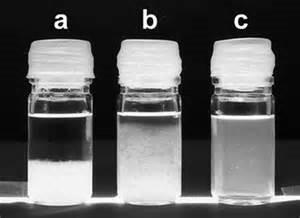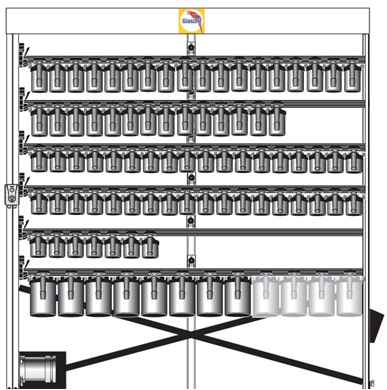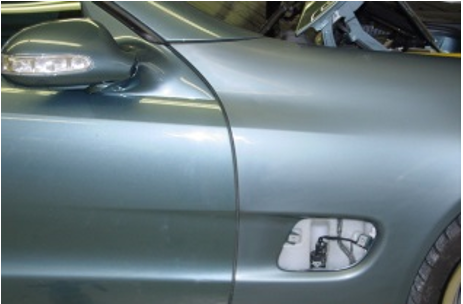Provides technicians with a thorough explanation of the color and paint preparation to avoid failures during the mixing process.
INTRODUCTION
Obtaining refinish paint that is ready to be applied on the car often requires different products to be mixed. A variety of equipment is needed to enable the mixing process and to make this more convenient and efficient. To avoid failures during the mixing process, a certain level of expertise on the functions of products and equipment and related rules is mandatory.
PREVIOUS MODULES
- BASIC KNOWLEDGE - COLOR
- COLOR RETRIEVAL - RATIO SCAN II
- COLOR RETRIEVAL - RATIO SCAN 12/6
- COLOR RETRIEVAL - COLOR RROFI SYSTEM CPS
|
Use safety glasses. |
Wear protective shoes. |
Wear standard overall. |
|
Use spray mask. |
Wear gloves. |
-
BASIC KNOWLEDGE - HEALTH & SAFETY
GENERIC INFORMATION ON MIXING COLORS
For dispersions of solid pigments in liquid resin or resin solution, the pigments always tend to settle to the bottom (left image). It is also possible for part of the resin to separate from the dispersion at the top (right image).


Sedimentation of pigments Separation of resin
The paint has to be remixed with suitable processes and equipment in order to remove pigment sedimentation and resin separation. The most common process involves stirring the paint, for example, with a mixing stick, until all sediment is removed from the bottom and the paint is visually homogenized. It is mandatory to ensure that the paint is thoroughly stirred (homogeneous) before any volumes are siphoned off. Ignoring this rule could result in a negative impact on the paint properties (such as color, tinting intensity, viscosity, reactivity, filling properties).
When different paint products or components are mixed, they also have to be thoroughly stirred (homogenized) so that the mixture takes on the targeted properties in regard to color, viscosity and drying behavior. This is mostly achieved by stirring it with a mixing stick.

Metal mixing stick
The recommended mixing ratios must be followed to achieve the targeted performance. The mixing ratios may be defined by weight (e.g. mixing formulas for colors) to be mixed on a scale. Some mixing ratios are also defined by volume, for instance, for adding hardener or reducer, applied with a mixing stick or scales on mixing cups.

Mixing cups with mixing scales by volume
Paint material should be stored in dry conditions and not at extreme temperatures. A pictogram on the label indicates products that are sensitive to freezing. When such products that are sensitive to freezing are stored below 0°C, they are no longer viable and must be disposed of. The material temperature must be at least 15°C for the materials to be applied.
|
Protect from freezing |
Store in a cool area |
Protect from humidity |
|
Seal container carefully |
Observe shelf life |
FURTHER SURVEY OF GENERAL PICTOGRAMS
Furthermore, you will find on the labels of the products more pictograms for mixing and processing of the products. The pictograms and their meaning are listed below:
PRE-TREATMENT RELATED PICTOGRAMS
-
See data sheet
- Cleaning
MIXING RELATED PICTOGRAMS
|
Mixing ratio 1:1 for 2 components |
Mixing ratio for 2 components |
Mixing ratio for 3 components |
|
Use mixing stick |
Hardener additio |
Mixing |
|
Shake aerosol can before use |
Shake can before use |
Avoid bumps, friction and impact |
VISCOSITY ADJUSTMENT RELATED PICTOGRAMS
 Application viscosity
Application viscosity
APPLICATION RELATED PICTOGRAMS
|
Gravity gun |
Number of spraycoats |
Body-filling |
|
Brushing |
Roller coating |
Aerosol |
DRYING RELATED PICTOGRAMS
|
Flash-of |
Drying time |
Infrared |
|
Ultraviolet |
|
COLOR RELATED PICTOGRAMS
|
Mixing |
Stirring in mixing machine |
Color checking |
|
Blending in |
Limited hiding power |
Mixing formula being revised |
|
Overall respray |
Immiscible |
Variants |
|
This color contains a Special Product. It can be ordered from your distributor |
Special mixing color. This color can be ordered from your distributor. |
Color for interior |
|
Color for engine compartment / boot |
Color for wheel rim and hubcap |
Formula uses mixing base that is being phased out |
|
Multi-tone color combination |
Textured color |
Mat color |
|
Tinted clear |
1-coat solid full gloss color or base coat for multilayer color |
Ground coat |
|
Clear coat |
Three stage painting (multi-coat) |
Paint system |
|
Color for accent |
Color for stripe |
Color for roof |
|
Color for accessories |
Hang-on part |
MIXING SHELF
The mixing machines are designed to store all basecoat/topcoat mixing and tinting bases and to ensure that they remain stirred or mixed (homogeneous.)

Mixing Machine
 All national regulations regarding explosion protection and the storage of flammable liquids must be observed.
All national regulations regarding explosion protection and the storage of flammable liquids must be observed.
Never store mixing bases at extreme temperatures. The air temperature in the paint mixing room must be no lower than +15°C. The mixing machine must be kept clean at all times.

Mixing Machine drawing
MIXING LIDS
The mixing lids come as complete units that consist of the stirring blade, lid and drive mechanism. The height of the units is pre-set.
Thoroughly stir the mixing bases by hand before attaching the mixing lid. Use a metal stirring stick for bare metal cans that leaves visible marks on the bottom of the can.
 Be careful with inside coated cans or with plastic cans. Metal mixing sticks can damage the coating of the can or the plastic. For these cans it could be better to use plastic mixing sticks.
Be careful with inside coated cans or with plastic cans. Metal mixing sticks can damage the coating of the can or the plastic. For these cans it could be better to use plastic mixing sticks.
|
Paint can with no marks from the mixing stick scraping on the bottom of the can - not stirred well |
Paint can with marks from the mixing stick scraping on the bottom of the can - stirred well |
The mixing lid does not touch the bottom of the can and cannot remove sediment (should there be any).

Diagram depicting the placement of the mixing blades of a mixing lid in the paint can. (1) Distance of the mixer from the bottom approx. 1-1.5 mm
After manual stirring, place the mixing lid on the open mixing base can and use closing mechanism. The unit is now ready for use.
Only use one mixing lid for one mixing base.
 Not following these instructions will result in color drift.
Not following these instructions will result in color drift.

Color differences between the fender and door due to insufficient maintenance of the mixing shelf
OPERATION
Run the mixing machine for approximately 10-15 minutes twice a day (once in the morning and once in the evening) and after a new mixing base is put into the mixing shelf.
 Check that all stirrers are moving.
Check that all stirrers are moving.
Stirring may be initiated manually each time or initiated automatically for multiple mixing machines (please refer to the user manual of the individual machines). Keep the spout of the lid clean to facilitate exact measurement of the mixing bases.
MAINTENANCE/INSTALLATION
Refer to the user manual of the supplier for all maintenance work.
 Follow all safety advice on the machine and in the user manual.
Follow all safety advice on the machine and in the user manual.
NOTE: All nationally and/or locally applicable working directions, operating instructions and safety regulations as well as existing rules for the prevention of accidents and regulations on dangerous substances must be observed.
Do not open any housing for maintenance work before the system is disconnected from the power supply.
MIXING FORMULAS 90 LINE
MIXING CUPS/MIXING STICKS
A container is required for mixing a color. Three main options are available to you:
Cylindrical metal cans. Use a mixing stick to add hardener and reducer by volume to prepare ready-to-use paint.
 When you mix waterborne paint, use cans which are coated or lacquer lined and protected against corrosion.
When you mix waterborne paint, use cans which are coated or lacquer lined and protected against corrosion.
|
Metal can |
Plastic can |
Mixing Stick |


RODIM mixing cup with lid and scales by volum RODIM system cup
Disposable mixing cups
These cups are available in different sizes and are compatible with various waterborne and solventborne systems. These cups have anti-static properties and can be stacked, provide scales for most relevant mixing ratios and the bottom of the cup is flat. This tapered (conical) shape makes it impossible to use these cups in combination with mixing sticks. Therefore, you have to use the scales on the sides of the cups. These scales take into account the tapered (conical) shape of the cups.
System cups
These cups offer the benefit that they can be closed with a lid that can be mounted on a spray gun, making it possible to apply the material directly from this cup (such as RODIM). This supports process efficiency by avoiding refilling and cleaning processes.
Should you wish to store the mixed paint in a cup, a tightly sealing lid must be placed on the cups to avoid the evaporation of solvents and contamination by dirt.
PROFIT MANAGER - COLOR MIXING PROCESS WITH 90 LINE
Put a metal can, mixing cup or system cup on the scale. Start the Glasurit Profit Manager and select the correct formula. The following screen will appear:
Enter the desired quantity
Press F3 or the button, the please place can on scale and press enter, or the OK button.

Profit Manager screen displaying the mixing formula to be mixed
The following pop-up window shows the first component and the quantity you have to pour into the can. Follow the instructions given in the mixing formula precisely and also weight the paint precisely. Keep the spout of the lid clean to make exact measuring of the mixing bases easier. Press F12 or the button after the first component.
Press F12 or the button after the first component

Pop-up window in Profit Manager monitoring the scaling process of the individual ingredient
This is followed by the next components. The start screen will appear after the last component.

A painter pouring a mixing base during the scaling process of a mixing formula
NOTE: After the last component has been entered (depending on the settings) you will be asked if you want to make this formula RFU by pressing the F2 button or pressing the Esc button to go back to finish the mix.
Remove the cup from the scale and stir immediately.
For color-related reasons, stirring should be performed from the side of the can toward the center, making sure that any paint clinging to the stick is carefully scraped off into the can and stirred.

The material must be immediately stirred after adding the last component.
In the event of an error during the scaling process such as pouring too much of a single mixing base, it is possible to recalculate the formula. For color accuracy, we always recommend applying the recalculation and adding the appropriate volumes of the subsequent mixing bases, even if the total scaled volume is increased.The new amount of paint is displayed on the screen after overpouring. Depending of the new amount, the selected can could be too small.
NOTE: The mixing machine, the reading device/work station and scale must be kept clean at all times.
READY-FOR-USE 90 LINE
After stirring, dilute 2 parts (vol.) of the mixture with 1 part (vol.) 93-E 3 Adjusting Base
Use mixing stick for 2:1 ratio.
- Fill up with mixed paint on the 1st scale (left)
- Fill up to here with 93-E3 up to the same number on the 2nd scale (right)


FORMULA COMPOSITION OF THE MIXTURE
 50% 93-E3 Adjustment Base
50% 93-E3 Adjustment Base- 100 % mixing formula (mixed formula)

The paint has to be stirred immediately after adding 93-E 3
When using white colors with a high spray viscosity, the mixing ratio can be changed from 100:50 to 100:80. Follow the instructions on mixing ratios with reducer and hardeners precisely.
As an alternative, you could also add the 93-E3/93-E3 slow Adjustment Base on the scale in combination with the Profit Manager software. The benefit is that the volumes for 93-E3/93-E3 slow may be considered in the inventory management. (Stock control)
CLEARCOAT - UNDERCOAT
Mixing ratio with hardener and reducer as described in Technical data sheet of each single Clearcoat.
Use mixing stick with right mixing ratio.
Follow the instructions on mixing ratios with reducers and hardeners.
As an alternative, you could also add hardener and reducer on the scale in combination with the Profit Manager software.
PAINT STRAINER

RODIM paint strainer 190 µm
During the entire mixing process, there is a risk of the paint becoming contaminated with dirt particles from the surrounding area. Typical contamination includes dust from the environment or droplets of dried paint on containers, clothing, equipment and tools. To reduce the risk, ensure a clean environment and regular and efficient cleaning processes. Further, we recommend straining the paint with paper strainers or special strainers within the paint system cups. The recommended mesh sizes for these strainers range (specially for Basecoats) from 180 to 240 µm (Clearcoats 100-125 µm). These mesh sizes make it possible to remove individual large dirt particles while providing a sufficient paint flow. For straining waterborne materials, the glue of the strainer has to be water-resistant and the mesh must not swell. Textured paint materials are exempt from this rule. These materials are not strained as to avoid removing the texture from the system.
SHELF LIFE OF MIXED COLORS
90 LINE
Shelf life of mixed colors (without 93-E3) and ready-for-use material (with 93-E3)
We would like to point out that the shelf life is influenced by many factors that are beyond our control.
Allows customers to use the leftover material and avoid waste.
- 90 Line mixing formula:
- 6 months without 93-E3 in the mixing formula
- Allows customers to mix larger amounts of 90 Line for color shades with high turnover. The requirement is storage in corrosion-resistant (plastic or internally coated) closed cans. Or coated / lacquer lined cans.
- 90 Line ready-for-use: ~1 week
DAISY WHEEL IN COMBINATION WITH 90 LINE
A Daisy Wheel is a fully automatic dosing system for the refinish business. It is a piece of equipment that is able to mix, store and dose all your paint with high accuracy.
The equipment stops the settling behavior of the mixing bases by way of continuous rotation of the wheel. At the same time, the machine is unable to remove existing sediments. It is therefore mandatory for all mixing bases to be stirred properly before they are filled into special Daisy Wheel containers.
The scaling process is completely automatic. You just have to place the cup into the machine and start the mixing process. The machine selects mixing bases and the scaling process required.
After the scaling process is complete, take the cup out of the machine, stir manually with a mixing stick and adjust the mixing formula ready-for-use afterwards.

Daisy Wheel

























































 50% 93-E3 Adjustment Base
50% 93-E3 Adjustment Base

